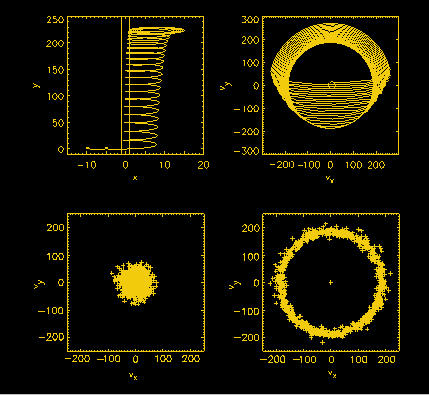



Next: The M87 jet: a
Up: Research highlights
Previous: Research highlights
Lewis Ball and David Galloway have been investigating
the passage of charged particles through magnetized shock waves
- a system which sometimes leads to chaos.
Shock waves are sudden changes in fluid properties such as density and
pressure, which arise whenever a fluid flows faster than the speed at
which pressure information can propagate - the sound speed in an
unmagnetized gas. Shocks are ubiquitous in astrophysics since rapid
fluid flows occur naturally as a result of tremendously energetic
processes like explosions or the collapse of a star. Much of the
matter in astrophysical systems is ionized - comprised of particles
which have a net positive or negative electric charge - and these
components lead to, and in turn are influenced by, electric and
magnetic fields. In such systems flows which are faster than the
Alfvén speed, the speed at which changes in the magnetic field can
propagate, lead to the formation of shocks.
The structures of the electric and magnetic fields in astrophysical
shocks have only recently started to be appreciated. The orbits of
charged particles which pass through astrophysical shocks can exhibit
some of the characteristics of chaotic systems as they are influenced
by the highly structured electric and magnetic fields. This can lead
to an increase in the average particle energy which may account for
spacecraft observations of energetic electron distributions at shocks
which propagate out from the Sun.
Lewis Ball and David Galloway, together with Vacation Scholar
William Gauvin, and third year student Stojan Karlusic, have been
investigating the details of electron orbits as they encounter a shock
wave. They have found that although the orbits do show some of the
characteristics of mathematical chaos, the chaotic nature is of more
novelty value than physical importance. Nevertheless, a physical
criterion which determines when the shock properties can induce chaotic
motions also determines when the heating of the electrons is significant.
This work is still in its early stages and much remains to be done. It
may lead to a better understanding of how shocks accelerate electrons
to moderate energies, and may also provide a means of studying the
field structures in shocks through observations of the resulting
electron distributions. More speculatively, this mechanism may be
relevant to the ``electron injection problem'' which refers to the
apparent need for electrons to be preaccelerated to many times the
Alfvén speed before the diffusive acceleration process - which is
apparently effective in many astrophysical shocks - can boost
their energies to the enormous levels needed to explain the radio
emission observed from a wide variety of sources.
 The figure illustrates the encounters of electrons with a magnetized shock.
The top panels show the orbit of a single electron encountering a shock;
the left panel shows the orbit in space - the shock is located between
the vertical lines - and the right panel shows the trace of the particle's
two velocity coordinates in the plane of the shock.
The lower panels show the effect of the shock on a distribution of 1000 electrons; the left panel shows a cool distribution of electrons well upstream of the shock and the right panel shows the distribution which results well downstream of the shock
- the average electron energy is increased considerably by the passage of the shock.
The figure illustrates the encounters of electrons with a magnetized shock.
The top panels show the orbit of a single electron encountering a shock;
the left panel shows the orbit in space - the shock is located between
the vertical lines - and the right panel shows the trace of the particle's
two velocity coordinates in the plane of the shock.
The lower panels show the effect of the shock on a distribution of 1000 electrons; the left panel shows a cool distribution of electrons well upstream of the shock and the right panel shows the distribution which results well downstream of the shock
- the average electron energy is increased considerably by the passage of the shock.




Next: The M87 jet: a
Up: Research highlights
Previous: Research highlights
Special Research Centre for Theoretical Astrophysics
 The figure illustrates the encounters of electrons with a magnetized shock.
The top panels show the orbit of a single electron encountering a shock;
the left panel shows the orbit in space - the shock is located between
the vertical lines - and the right panel shows the trace of the particle's
two velocity coordinates in the plane of the shock.
The lower panels show the effect of the shock on a distribution of 1000 electrons; the left panel shows a cool distribution of electrons well upstream of the shock and the right panel shows the distribution which results well downstream of the shock
- the average electron energy is increased considerably by the passage of the shock.
The figure illustrates the encounters of electrons with a magnetized shock.
The top panels show the orbit of a single electron encountering a shock;
the left panel shows the orbit in space - the shock is located between
the vertical lines - and the right panel shows the trace of the particle's
two velocity coordinates in the plane of the shock.
The lower panels show the effect of the shock on a distribution of 1000 electrons; the left panel shows a cool distribution of electrons well upstream of the shock and the right panel shows the distribution which results well downstream of the shock
- the average electron energy is increased considerably by the passage of the shock.